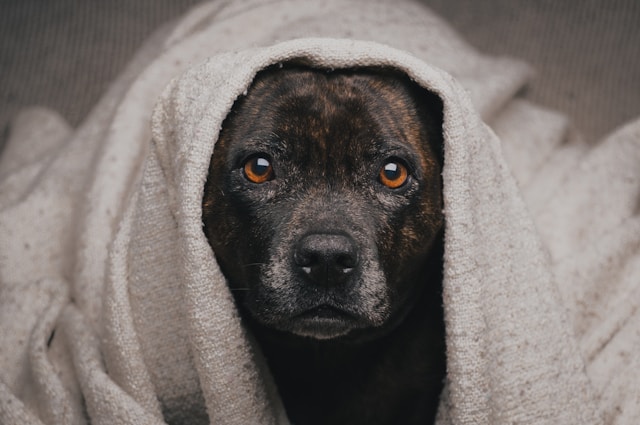
Preparing Your Dog for Spring Thunderstorms: Desensitization & Anxiety Tips
As spring rolls in with blooming flowers and longer days, it also brings something many dog owners dread: thunderstorms. For humans, a thunderstorm might be little more than a passing weather event. But for many dogs, it’s a terrifying, overwhelming experience.
Panting, pacing, trembling, hiding, or even destructive behavior during a storm are common signs of storm anxiety in dogs. If you’ve watched your furry friend suffer through each rumble of thunder or flash of lightning, you’re not alone—and thankfully, there are proactive, gentle ways to help them cope.
This guide will cover practical, proven strategies to desensitize your dog to thunderstorm noise, reduce anxiety, and create a safe, comforting space they can retreat to during stormy weather.
Understanding Storm Anxiety in Dogs
Why Are Dogs Afraid of Thunderstorms?
Dogs have far sharper senses than humans. What may sound like distant thunder to us can be deeply unsettling to them. Factors that contribute to storm anxiety include:
- Loud noise sensitivity: Thunder can seem like a sudden, inescapable threat.
- Barometric pressure changes: Dogs may sense storms before they arrive, triggering anticipatory anxiety.
- Static electricity buildup: Some dogs feel uncomfortable static during storms, especially long-haired breeds.
- Flashes of lightning and wind gusts: Sudden visual and environmental changes can disorient them.
Storm anxiety is not a sign of weakness or bad training—it’s a legitimate canine fear response, often worsened if not addressed early.
Signs Your Dog Is Anxious During Thunderstorms
Even if your dog doesn’t show full-blown panic, they may be experiencing mild stress. Here are common signs to watch for:
- Panting or drooling
- Whining or barking excessively
- Trembling or shaking
- Hiding in tight spaces (closets, under furniture)
- Pacing or restlessness
- Trying to escape or dig
- Destructive behavior (chewing, scratching doors)
- Loss of bladder or bowel control
- Clinginess or seeking constant reassurance
The earlier you notice and respond to these signs, the easier it will be to implement long-term solutions.
Strategy 1: Desensitization Training
Desensitization involves gradually exposing your dog to storm-related sounds in a controlled, safe environment, helping them learn that these sounds don’t pose a threat.
How to Desensitize Your Dog to Storm Sounds
- Start with a Storm Soundtrack
- Download recordings of thunderstorm sounds from YouTube, Spotify, or pet behavior websites.
- Play the audio at a very low volume during calm, happy times (like after a meal or during playtime).
- Praise your dog or give treats while the sound plays quietly in the background.
- Gradually Increase Volume Over Time
- Over several sessions (days or weeks), slowly increase the volume—only if your dog remains relaxed.
- If your dog shows signs of stress, lower the volume and return to the last calm level.
- Pair Sounds with Positive Reinforcement
- Always associate the thunder sounds with good things: food, play, cuddles.
- Use high-value treats your dog loves (cheese, boiled chicken, liver snacks).
- Make Sessions Short and Positive
- 5–10 minute training sessions are ideal.
- End on a positive note before your dog becomes anxious or bored.
Desensitization takes time and patience, but it can significantly reduce your dog’s negative reactions during real storms.
Strategy 2: Counterconditioning
While desensitization changes your dog’s response to thunder over time, counterconditioning works to replace fear with calm during actual storms.
How It Works
- Identify your dog’s favorite calming activity or reward: Puzzle toys, treat-dispensing balls, tug games, or even cuddling.
- During a storm (or simulated storm), engage your dog in the activity.
- Over time, your dog begins to associate storms with something positive rather than fearful.
Example:
If your dog loves peanut butter in a Kong toy, reserve that special treat only for stormy moments. The reward becomes linked to the sound of thunder rather than the fear.
Strategy 3: Create a Safe Storm Sanctuary
Providing a quiet, cozy refuge can help your dog feel more secure when storms hit.
How to Set Up a Storm Den
- Choose a quiet, windowless room or area (bathroom, closet, under the stairs).
- Add soft bedding, your dog’s favorite toys, and a worn shirt or blanket with your scent.
- Use white noise machines or calming music to muffle the sound of thunder.
- Consider using crates if your dog sees them as safe spaces—but never force them inside if they’re resistant.
Once you create the space, encourage your dog to use it even when it’s not storming so it becomes familiar and comforting.
Strategy 4: Use Natural Calming Aids
Several safe, natural products are designed to reduce anxiety in dogs. Always check with your vet before introducing new products.
Popular Options:
- Pheromone Diffusers (e.g., Adaptil)
Mimic the comforting pheromones released by mother dogs to calm puppies. Available as plug-in diffusers, sprays, or collars. - Calming Treats and Supplements
Look for ingredients like:- L-theanine
- Chamomile
- Valerian root
- Tryptophan
- Melatonin (only under vet guidance)
- Thundershirts or Anxiety Wraps
These snug-fitting garments apply gentle, constant pressure that mimics swaddling, which many dogs find reassuring. - Herbal Calming Sprays or Mists
Use around their bedding or in their storm sanctuary.
These aids work best when combined with behavior training, not as standalone solutions.
Strategy 5: Train Storm Routines and Predictability
Dogs thrive on routine. Creating a consistent “storm plan” helps build a sense of safety.
Tips for a Storm Routine:
- Use a verbal cue like “storm time” before guiding your dog to their sanctuary.
- Practice calm behavior yourself—dogs pick up on your anxiety.
- Keep storm-related routines the same each time (e.g., calming music + treat toy + cozy blanket).
- Avoid excessive coddling, which may reinforce fear. Comfort your dog gently, but stay calm and matter-of-fact.
Strategy 6: Professional Support for Severe Anxiety
If your dog’s fear of thunderstorms is intense, doesn’t improve with training, or includes self-harming behaviors, it’s time to call in help.
Options Include:
- Veterinary Consultation: Your vet can check for health issues, offer medication options, or refer you to specialists.
- Certified Veterinary Behaviorist (DACVB): For dogs with extreme phobias or trauma history.
- Positive Reinforcement Dog Trainer: Especially one who specializes in desensitization and anxiety behaviors.
Medication is sometimes prescribed in combination with behavior modification—especially during storm-heavy seasons.
Additional Tips for Thunderstorm Prep
- Monitor the weather forecast: Apps like AccuWeather can alert you ahead of time, giving you time to prepare.
- Exercise your dog before storms: A tired dog is generally calmer and less reactive.
- Close blinds and turn on lights: Reduce flashes from lightning, which can trigger anxiety.
- Keep ID tags updated: Anxious dogs may try to flee. Ensure microchips and collars are current, especially during storm season.
Thunder Anxiety vs. Noise Phobia: Know the Difference
Some dogs fear only storms, while others have a broader noise phobia that includes:
- Fireworks
- Gunshots
- Construction noises
- Loud household items (vacuum cleaners, blenders)
If your dog is anxious during multiple types of loud noise events, your training may need to be more comprehensive.
Real-Life Success Stories
Case 1: Max, the Golden Retriever
Max was once so anxious he chewed through drywall during a storm. After six months of slow desensitization using thunder recordings, Adaptil diffusers, and a Thundershirt, he now calmly naps during most storms.
Case 2: Luna, the Rescue Lab Mix
Luna had severe storm phobia rooted in past trauma. With the help of a veterinary behaviorist and calming chews, she now retreats to her storm den and relaxes when white noise plays—even during spring downpours.
These stories prove that change is possible with patience and persistence.
